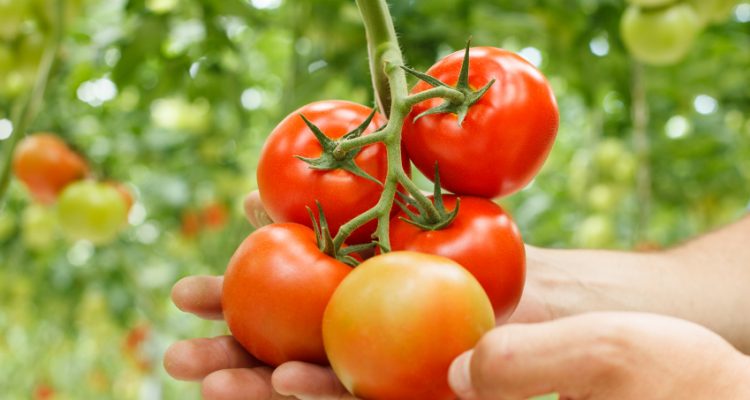
Tomatoes are one of the most popular and versatile fruits (yes, it’s technically a fruit—but it’s commonly classified as a vegetable because of how its flavor and aroma blends with other ingredients in recipes). Whether you’re eating them in soups, salads, or main dishes, you’ll be reaping the many benefits of tomatoes.
There are thousands of different varieties of tomatoes with a wide range of sizes, from the beefsteak tomato to the cherry tomato. They all have one thing in common: they’re all a rich source of nutrients containing an abundance of carotenes (vitamin A) and lycopene, a potent antioxidant. One large tomato has about 30 calories, two grams of fibre, two grams of protein, and almost five mg of lycopene. Half a cup of tomato sauce has 30 calories, two grams of protein, two grams of fiber, and almost 20 mg of lycopene.
In fact, because of the high lycopene content, one of the main benefits of tomatoes is their protective effects for heart disease and cancer. One meta-analysis found that with increased lycopene intake, there was a decreased risk of heart disease but no protective benefit from having a stroke.
Researchers have also tried to determine if the benefits of tomatoes extend to cancer, too. Another meta-analysis evaluating cancer risk found that many studies consistently show an increased intake of lycopene or tomato products is associated with a decreased risk of prostate cancer. While the results of some studies have been insignificant, it is recommended to have at least five servings of tomato or tomato products per week.
Tomatoes are not only a highly nutritious fruit but also have a brilliant color that adds to its appeal. And unlike many other fruits and vegetables, you can eat the whole fruit—the skin, flesh and seed—just remember to discard the toxic green leaves.
This fruit is in season from August through September because the most succulent tasting tomatoes are grown in ideal daytime temperatures of 80°F and night time temperatures of 60°F. Tomatoes need the sunshine as too much rain can dilute the fruit, negatively impacting the flavor. This climate produces the juiciest and most flavorful tomatoes with just the right ratio of sugar and acid. Tomatoes grown in soils rich in minerals such as potassium also help to enhance its flavor and preserve the benefits of tomatoes.
Locally grown tomatoes are the freshest and therefore have the best taste! Although they are available year round in your local grocery store, aim to purchase tomatoes when they are in season to reap the benefits of tomatoes.
You can even easily grow your own in your garden. Choose tomatoes that are firm and bright colored with perky, green leaves. Avoid purchasing or consuming tomatoes that have any mouldy patches. Try using canned tomatoes in the winter months to decrease your carbon footprint—just remember to check the sodium content and rinse them off prior to use.
If you want to get all the benefits of tomatoes, then you must store them correctly. Many people mistakenly refrigerate tomatoes right away. However, they are best enjoyed at room temperature. If they are not consumed within a few days of purchasing them, then consider refrigerating them in a perforated bag for only a couple days. Remove them from the refrigerator and allow them to adjust to room temperature to maximize your enjoyment of their taste.
Why not get the benefits of tomatoes by making tomato soup? Here’s an easy, healthy tomato soup recipe:
Healthy Tomato Soup Recipe
Ingredients
- 4 Medium tomatoes (2 cups of canned diced tomatoes)
- 1 teaspoon butter
- 1 Small onion
- 1 tablespoon flour
- 1 tablespoon ground flaxseed
- 1 tablespoon tomato paste
- 1 cup of broth—I make my own (or 1 cup of water)
- 1 tablespoon of finely chopped parsley or basil (I prefer fresh but dried works as well!)
- Salt and pepper to taste
Directions
| If you’re using canned tomatoes, you can skip this step (it comes out better with fresh tomatoes). Boil water in a medium sized sauce pan. Carve a small “x” at one side of each tomato. Reduce heat and place tomatoes in water for two to three minutes. Remove tomatoes and allow to cool. Remove tomato skins and either dice them or blend them in a blender to make a puree (this will depend on how smooth or chunky you want your soup). | |
| Melt butter in a medium sized saucepan over low-medium heat. | |
| Blend onions and then add to saucepan and cook for a few minutes until soft. | |
| Stir flour into saucepan for 1-2 minutes. | |
| Stir in flaxseed. | |
| Add tomato paste and stir for another 1-2 minutes. | |
| Add tomatoes and broth (water) to saucepan. Increase the heat and bring to a boil. | |
| Reduce heat to low, cover pot and simmer for about 30 minutes. | |
| Add salt and pepper to taste. | |
| Chop parsley or basil. | |
| Pour soup into individual bowls and stir in a sprinkle of parsley or basil. | |
Sources:
Bahar, “Tomato Soup,” 1001Recipe web site, 2007; http://www.1001recipe.com/recipes/food/tomato_soup/, last accessed July 30, 2013.
“Tomato,” BBC Good Food web site; http://www.bbcgoodfood.com/glossary/tomato, last accessed July 30, 2013.
Chen, J., “Lycopene/Tomato Consumption and the Risk of Prostate Cancer: A Systematic Review and Meta-Analysis of Prospective Studies,” Journal of Nutritional Science and Vitaminology 2013; 59:213-223.
“Canadian Nutrient File,” Health Canada web site, 2010; http://www.hc-sc.gc.ca/fn-an/nutrition/fiche-nutri-data/index-eng.php, last accessed July 30, 2013.
Jacques, P.F., “Relationship of lycopene intake and consumption of tomato products to incident CVD,” British Journal of Nutrition 2013; 110:545-551.














